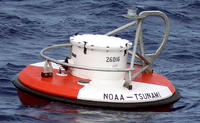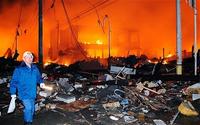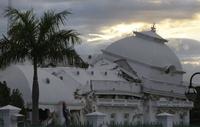-
Understanding crowd behavior in disasters
Researchers have developed a new model for the behavior of pedestrians and crowds; most simulation software is often based on physics-inspired assumptions, such as repulsive forces between pedestrians; the new, psychologically based model, in contrast, assumes that pedestrians try to minimize the coverage of their vision field, while adjusting the walking speed to keep a safety distance from other people; the new approach can help in understanding and preventing tragic crowd disasters, developing better architectural designs and new navigation approaches in robotics
-
-
U.S. tsunami warning system outdated

The two tsunami warning centers the National Oceanic and Atmospheric Administration (NOAA) operates are “remarkably outdated” and need upgrades, experts say; both centers need upgrades with common sets of hardware and software tools, which both lack today; it is estimated that design of the architecture and purchase of new hardware would cost about $2 million — a small investment to improve the warnings of potentially devastating events
-
-
Streamlined approach to U.S. preparedness
The administration has released a new presidential policy directive on national preparedness; the directive, the result of a comprehensive review of national preparedness policy, replaces Homeland Security Presidential Directive 8; the administration says that the directive seeks to move away from burdensome requirements and instead build the key capabilities the nation needs to confront any challenge
-
-
Protecting Japan from tsunamis
As Japan begins to rebuild after the massive 9.0 magnitude earthquake and tsunami, engineers are beginning to analyze the destruction to learn how to better prepare for future natural disasters; one expert says that prior to the earthquake, more infrastructures spending, particularly for projects aimed at preventing the approaching tsunami, could have mitigated much of the damage; the tsunami easily overwhelmed one of the tallest and longest seawalls in Japan; officials will have to decide whether to reinvest in costly tsunami infrastructure or to relocate communities further from the ocean to minimize the numbers affected by such events
-
-
Indiana prepares for major seismic event
Two of Indiana’s earthquake preparedness drills, the Great Central U.S. Shake Out scheduled for 19 April, and a training program in May for emergency management and response agencies are receiving increased interest following the devastating quake in Japan
-
-
Indian Point 50-mile evacuation plan unrealistic
Located only thirty-five miles north of New York City, the most populous area in the United States, is the Indian Point nuclear reactor; safety officials are questioning the wisdom of operating a plant so close to New York City; a fifty mile evacuation radius around the plant would affect nearly twenty million people and some say evacuating that many people on short notice is a “fantasy”; NRC is currently conducting a thorough safety review of U.S. nuclear plants and the Indian Point reactor is one of seventeen under scrutiny; New York Governor Andrew Cuomo recently called for the plant to be shut down
-
-
The problems with major disasters

There are three problems with major disasters: small miscalculations of probabilities can have large effects on outcomes when dealing with large events; our reward structures do not encourage spending the time or the money to deal with low-probability disasters; the very complexity of modern life — including our transportation and communication systems, our economy and our social interactions — is directly implicated in the severity of catastrophes; in more complex systems, even small changes or perturbations can have disproportionate and unpredictable effects
-
-
Risk-analysis models could not predict Arab world upheavals
Political instability is influenced by everything from the weather to local economic conditions and infant mortality rates; these factors interact in complex ways, and data quality can be low; together, this makes for a daunting forecasting challenge; says one expert: “All of our models are bad, some are less bad than others”
-
-
Haiti's quake damage yields better building codes

In the aftermath of the 7.0 magnitude earthquake that shook Haiti last year and killed more than 300,000 people, University of Arizona researchers descended upon the country’s capital to study buildings that survived the quake; researchers documented damaged buildings to develop a sophisticated three dimensional model; they are working to develop stricter building codes to ensure that buildings can withstand earthquakes in the future; their focus is on designing low-cost easy to implement localized solutions; buildings that were not built to withstand earthquakes were the primary cause of death in the disaster
-
-
Who is the culprit in the Queensland floods: man or nature?
Climate change may contribute to the intensification of natural disasters, but the major drivers of the rapidly rising costs of natural disasters — in Australia and around the world — are societal changes such as increases in population, wealth, and inflation, not climate change; the only way to reduce the scale of future disasters in Australia are risk-informed land planning policies with risks appropriately priced by an active insurance market; in simple terms, for flood and bushfire, this means an end to unmanaged development of flood plains or within bushlands
-
-
California prepares for major seismic event
Scientists are growing more wary about the potential for a major seismic event in California; earthquake trends show that intervals between such events have been as short as 45 years to as long as 145 years; considering that it has been 154 years since the last major quake, the San Francisco Bay Area, Delta Region, and Central Valley prepare for the worst
-
-
Plan for Massachusetts LNG site faces growing opposition
The Weaver’s Cove energy project will see up to seventy liquefied natural gas (LNG) tankers a year travel up Narragansett Bay to berth in Mt. Hope Bay; from there, a sub-sea pipe would carry the liquefied gas more than four miles up the Taunton River to a storage facility at a former oil terminal; Massachusetts and Rhode Island politicians work to block the Fall River storage facility, saying a terrorist attack or accident would place thousands of people in peril in the densely populated city and harm fish habitat and tourism
-
-
Debate over extending operation of aging NY reactor
The Indian Point Energy Center is located on the banks of the Hudson River just twenty-four miles north of Manhattan; its reactors are aging: the first reactor at the center began operating in 1962 and shut down in 1974; two new reactors were built in 1974 and 1976; the plant operator seeks permission from the U.S. government to extend operations at the plant; many locals oppose the extension, citing what they say are inadequate emergency evacuation plans in the event of a disaster, and the damage the plant cooling system inflicts on aquatic life
-
-
DHS seeks comments on small business preparedness plan
DHS seeks public comments on a private sector readiness certification program specifically tailored to the needs of small businesses; this first-of-its-kind program will tailor voluntary private sector preparedness certification standards to specifically meet the needs and capabilities of U.S. small businesses
-
-
Asteroids: Earth will be hit by a shotgun blast instead of a single cannonball
Scientists find that many asteroids are not solid rocks, but a collection of small gravel-sized rocks, held together by gravity; instead of a solid mountain colliding with Earth’s surface, the planet would be pelted with the innumerable pebbles and rocks of which it is composed, like a shotgun blast instead of a single cannonball; this knowledge could guide the defensive tactics to be taken if an asteroid were on track to collide with the Earth
-
- All
- Regional
- Water
- Biometrics
- Borders/Immig
- Business
- Cybersecurity
- Detection
- Disasters
- Government
- Infrastructure
- International
- Public health
- Public Safety
- Communication interoperabillity
- Emergency services
- Emergency medical services
- Fire
- First response
- IEDs
- Law Enforcement
- Law Enforcement Technology
- Military technology
- Nonlethal weapons
- Nuclear weapons
- Personal protection equipment
- Police
- Notification /alert systems
- Situational awareness
- Weapons systems
- Sci-Tech
- Sector Reports
- Surveillance
- Transportation
Advertising & Marketing: advertise@newswirepubs.com
Editorial: editor@newswirepubs.com
General: info@newswirepubs.com
2010-2011 © News Wire Publications, LLC News Wire Publications, LLC
220 Old Country Road | Suite 200 | Mineola | New York | 11501
Permissions and Policies
Editorial: editor@newswirepubs.com
General: info@newswirepubs.com
2010-2011 © News Wire Publications, LLC News Wire Publications, LLC
220 Old Country Road | Suite 200 | Mineola | New York | 11501
Permissions and Policies
